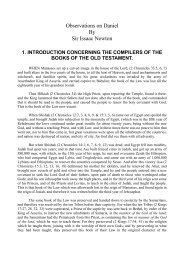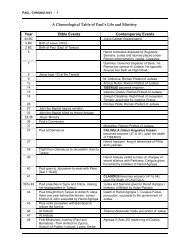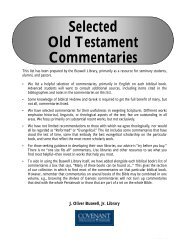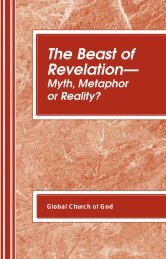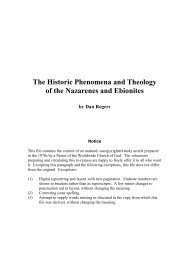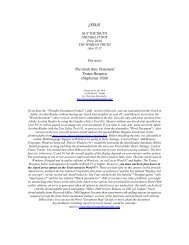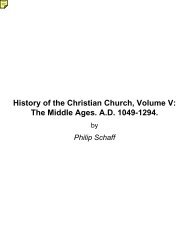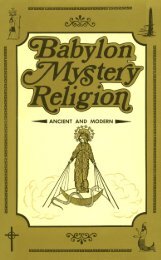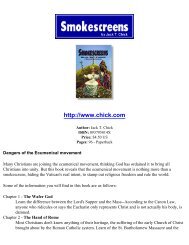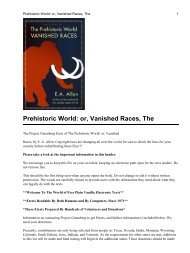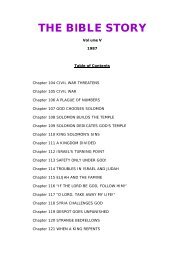Legends of the Shawangunk2 JR.pdf - Friends of the Sabbath ...
Legends of the Shawangunk2 JR.pdf - Friends of the Sabbath ...
Legends of the Shawangunk2 JR.pdf - Friends of the Sabbath ...
You also want an ePaper? Increase the reach of your titles
YUMPU automatically turns print PDFs into web optimized ePapers that Google loves.
16 <strong>Legends</strong> <strong>of</strong> <strong>the</strong> Shawangunk.<br />
Tradition says <strong>the</strong>y landed at <strong>the</strong> mouth <strong>of</strong> Esopus Creek, and journeyed up until <strong>the</strong>y<br />
reached <strong>the</strong> flats <strong>of</strong> Kingston. Here Chambers received a “free gift” <strong>of</strong> territory from <strong>the</strong><br />
natives.<br />
In 1655 a general war broke out between <strong>the</strong> Indian tribes on both sides <strong>of</strong> <strong>the</strong><br />
Hudson, and <strong>the</strong> whites <strong>of</strong> Amsterdam and vicinity. When <strong>the</strong> news <strong>of</strong> this outbreak<br />
reached Esopus <strong>the</strong> inhabitants all fled, leaving <strong>the</strong>ir stock, dwellings and crops to <strong>the</strong><br />
mercy <strong>of</strong> <strong>the</strong> savages. This action was <strong>the</strong> more necessary, as <strong>the</strong> few inhabitants were<br />
living scattered on <strong>the</strong>ir farms, without even a block-house for protection. During <strong>the</strong>ir<br />
absence <strong>the</strong>ir empty houses and unprotected grain was appropriated by <strong>the</strong> Indians.<br />
Albany records say <strong>the</strong> farmers returned to <strong>the</strong>ir homes as soon as peace was restored.<br />
It had been <strong>the</strong> purpose <strong>of</strong> <strong>the</strong> Directors <strong>of</strong> <strong>the</strong> West India Company to construct a<br />
fort at Esopus, and orders had been issued to that effect. The orders were not obeyed,<br />
hence <strong>the</strong> unprotected state <strong>of</strong> <strong>the</strong> settlement. The savages had <strong>the</strong>ir wigwams all around<br />
<strong>the</strong> farms <strong>of</strong> <strong>the</strong> white people, and <strong>the</strong>ir maize-fields and bean-patches were near to each<br />
o<strong>the</strong>r. The hogs, cows, and horses <strong>of</strong> <strong>the</strong> settlers roamed at will on <strong>the</strong> untitled flats,<br />
frequently destroying <strong>the</strong> crops <strong>of</strong> <strong>the</strong> Indian women. This made <strong>the</strong> Indians mad, and<br />
<strong>the</strong>y complained <strong>of</strong> <strong>the</strong> depredations <strong>of</strong> <strong>the</strong> stock to <strong>the</strong> owners, but <strong>the</strong> animals still<br />
roamed.<br />
Now and <strong>the</strong>n a pig was found dead with an arrow or bullet in it. Now it was <strong>the</strong><br />
Christian’s turn to get mad. Still it might have been possible for <strong>the</strong> whites and Indians to<br />
have lived toge<strong>the</strong>r in comparative amity, but for an additional source <strong>of</strong> trouble.<br />
Jacob Jansen Stohl, agent for <strong>the</strong> Governor at Esopus, wrote to Stuyvesant to <strong>the</strong><br />
following purport: “The people <strong>of</strong> Fort Orange (Albany) sell liquor to <strong>the</strong> Indians so that<br />
not only I, but all <strong>the</strong> people <strong>of</strong> <strong>the</strong> Great Esopus, daily see <strong>the</strong>m drunk, from which<br />
nothing good, but <strong>the</strong> ruin <strong>of</strong> <strong>the</strong> land, must be <strong>the</strong> consequence.”<br />
In <strong>the</strong>se transactions <strong>the</strong> whites were sometimes more to blame than <strong>the</strong> savages, and<br />
yet <strong>the</strong>y wrote in this wise: “Christ did not forsake us; He collected us in a fold. Let us<br />
<strong>the</strong>refore not forsake one ano<strong>the</strong>r, but let us s<strong>of</strong>ten our mutual sufferings.”<br />
In a letter from Thomas Chambers to Governor Stuyvesant, dated May, 1658, we find<br />
additional evidence <strong>of</strong> <strong>the</strong> baneful effects <strong>of</strong> <strong>the</strong> strong drink sold to <strong>the</strong> savage. He<br />
writes in substance: “I saw that <strong>the</strong> savages had an anker (ten-gallon keg) <strong>of</strong> brandy lying<br />
under a tree. I tasted [it] myself and found it was pure brandy. About dusk <strong>the</strong>y fired at<br />
and killed Harmen Jacobsen, who was standing in a yacht in <strong>the</strong> river; and during <strong>the</strong><br />
night <strong>the</strong>y set fire to <strong>the</strong> house <strong>of</strong> Jacob Adrijansa, and <strong>the</strong> people were compelled to flee<br />
for <strong>the</strong>ir lives. Once before we were driven away and expelled from our property; as long<br />
as we are under <strong>the</strong> jurisdiction <strong>of</strong> <strong>the</strong> West India Company we ask your assistance, as<br />
Esopus could feed <strong>the</strong> whole <strong>of</strong> New Ne<strong>the</strong>rland. I have informed myself among <strong>the</strong><br />
Indians who killed Harmen, and <strong>the</strong>y have promised to deliver <strong>the</strong>



